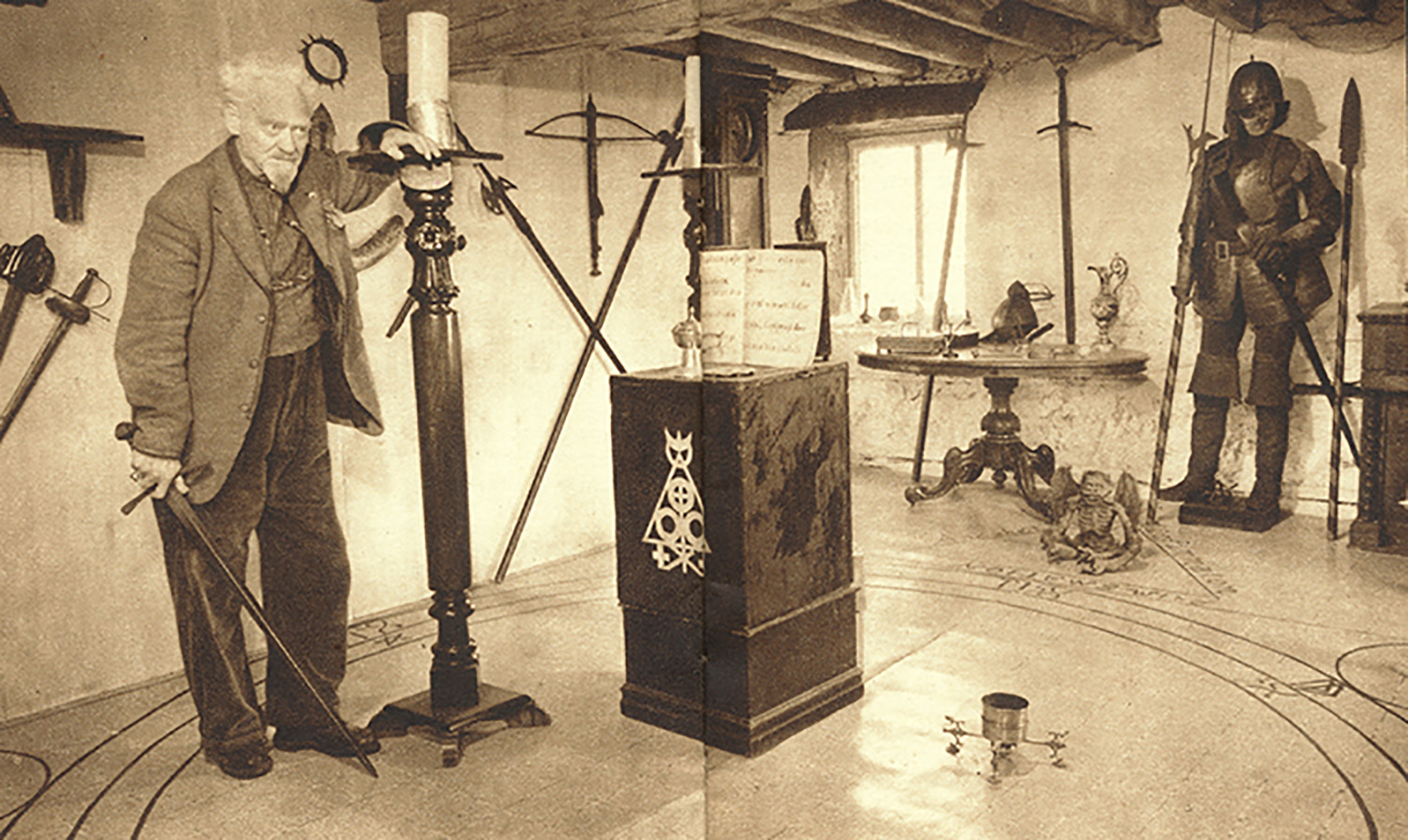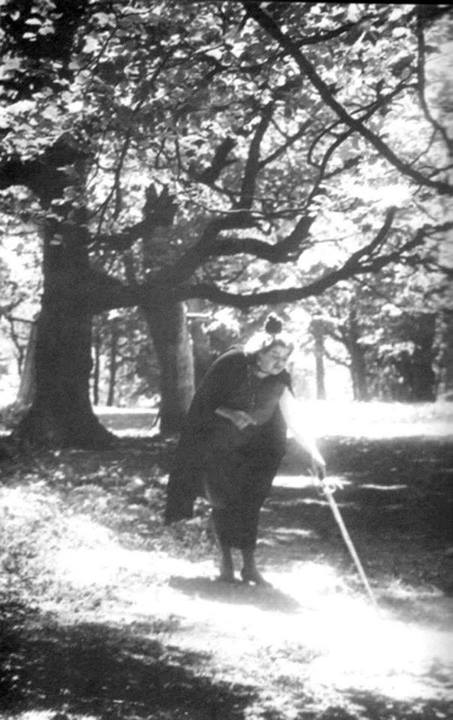Gardnerian Wicca
Gardnerian Wicca, or Gardnerian witchcraft, is a tradition in the neopagan religion of Wicca, whose members can trace initiatory descent from Gerald Gardner.
The tradition is itself named after Gardner (1884–1964), a British civil servant and amateur scholar of ritual magic. The term "Gardnerian" was probably coined by the founder of Cochranian Witchcraft, Robert Cochrane in the 1950s or 60s, who himself left that tradition to found his own.
History
On retirement from the British Colonial Service, Gardner moved to London but then before World War II moved to Highcliffe, east of Bournemouth and near the New Forest on the south coast of England. After attending a performance staged by the Rosicrucian Order Crotona Fellowship, he reports meeting a group of people who had preserved their historic occult practices. They recognised him as being "one of them" and convinced him to be initiated. It was only halfway through the initiation, he says, that it dawned on him what kind of group it was, and that witchcraft was still being practised in England.
The group into which Gardner was initiated, known as the New Forest coven, was small and utterly secret as the Witchcraft Act of 1735 made it illegal to claim to predict the future, conjure spirits, or cast spells; it likewise made an accusation of witchcraft a criminal offence. Gardner's enthusiasm over the discovery that witchcraft survived in England led him to wish to document it, but both the witchcraft laws and the coven's secrecy forbade that, despite his excitement.
After the witchcraft laws were repealed in 1951, and replaced by the Fraudulent Mediums Act, Gerald Gardner went public, publishing his first non-fiction book about witchcraft, Witchcraft Today, in 1954. Gardner continued, as the text often iterates, to respect his oaths and the wishes of his High Priestess in his writing.
Gardner knew many famous occultists. Near the end of Aleister Crowley's life, Gardner met with him for the first time on 1 May 1947 and visited him twice more before Crowley's death that autumn; at some point, Crowley gave Gardner an Ordo Templi Orientis (OTO) charter and the 4th OTO degree—the lowest degree authorising use of the charter. Aleister Crowley played a crucial role in inspiring Gardner to establish a new pagan religion.
The witches Gardner was originally introduced to were originally referred to by him as "the Wica" and he would often use the term "Witch Cult" to describe the religion. Other terms used, included "Witchcraft" or "the Old Religion." Later publications standardised the spelling to "Wicca" and it came to be used as the term for the Craft, rather than its followers. "Gardnerian" was originally a pejorative term used by Gardner's contemporary Roy Bowers (also known as Robert Cochrane), a British cunning man, who nonetheless was initiated into Gardnerian Wicca a couple of years following Gardner's death.
Wiccan rituals
Gardner stated that the rituals of the existing group were fragmentary at best, and he set about fleshing them out, drawing on his library and knowledge as an occultist and amateur folklorist. Gardner borrowed and wove together appropriate material from other artists and occultists, most notably Charles Godfrey Leland's Aradia, or the Gospel of the Witches, the Key of Solomon as published by S. L. MacGregor Mathers, Masonic ritual, Crowley, and Rudyard Kipling.
Gardner reported that witches were taught that the power of the human body can be released, for use in a coven's circle, by various means, and released more easily without clothing. A simple method was dancing round the circle singing or chanting; another method was the traditional "binding and scourging." In addition to raising power, "binding and scourging" can heighten the initiates' sensitivity and spiritual experience.
Following the time Gardner spent on the Isle of Man, the coven began to experiment with circle dancing as an alternative. It was also about this time that the lesser 4 of the 8 Sabbats were given greater prominence. Bricket Wood coven members liked the Sabbat celebrations so much, they decided that there was no reason to keep them confined to the closest full moon meeting, and made them festivities in their own right. As Gardner had no objection to this change suggested by the Bricket Wood coven, this collective decision resulted in what is now the standard eight festivities in the Wiccan Wheel of the year.
Covens and initiation
Gardnerian Wiccans organise into covens, that traditionally, though not always, are limited to thirteen members. Covens are led by a High Priestess and the High Priest of her choice, and celebrate both a Goddess and a God.
Gardnerian Wicca and other forms of British Traditional Wicca operate as an initiatory mystery cult; membership is gained only through initiation by a Wiccan High Priestess or High Priest. Any valid line of initiatory descent can be traced all the way back to Gerald Gardner, and through him back to the New Forest coven.
Rituals and coven practices are kept secret from non-initiates, and many Wiccans maintain secrecy regarding their membership in the religion. Whether any individual Wiccan chooses secrecy or openness often depends on their location, career, and life circumstances. In all cases, Gardnerian Wicca absolutely forbids any member to share the name, personal information, fact of membership, and so on without advanced individual consent of that member for that specific instance of sharing.
In Gardnerian Wicca, there are three grades of initiation. Ronald Hutton suggests that they appear to be based upon the three grades of Freemasonry.
Theology
In Gardnerian Wicca, the two principal deities are the Horned God and the Mother Goddess. Gardnerians use specific names for the God and the Goddess in their rituals. Doreen Valiente, a Gardnerian High Priestess, revealed that there were more than one.
Ethical beliefs
The Gardnerian tradition teaches a core ethical guideline, often referred to as "The Rede" or "The Wiccan Rede." In the archaic language often retained in some Gardnerian lore, the Rede states, "An it harm none, do as thou wilt."
Two features stand out about the Rede. The first is that the word rede means "advice" or "counsel." The Rede is not a commandment but a recommendation, a guideline. The second is that the advice to harm none stands at equal weight with the advice to do as one wills. A second ethical guideline is often called the Law of Return, sometimes the Rule of Three, which mirrors the physics concept described in Sir Isaac Newton's Third Law of Motion: "For every action, there is an equal and opposite reaction."
In Gardnerian Wicca, these tradition-specific teachings demand thought before action, especially magical action (spell work). An individual or a coven uses these guidelines to consider beforehand what the possible ramifications may be of any working. Given these two ethical core principles, Gardnerian Wicca hold themselves to a high ethical standard.
The religion tends to be non-dogmatic, allowing each initiate to find for themselves what the ritual experience means by using the basic language of the shared ritual tradition, to be discovered through the Mysteries. The tradition is often characterised as an orthopraxy (correct practice) rather than an orthodoxy (correct thinking), with adherents placing greater emphasis on a shared body of practices as opposed to faith.

